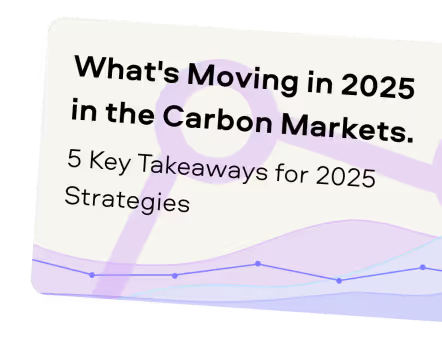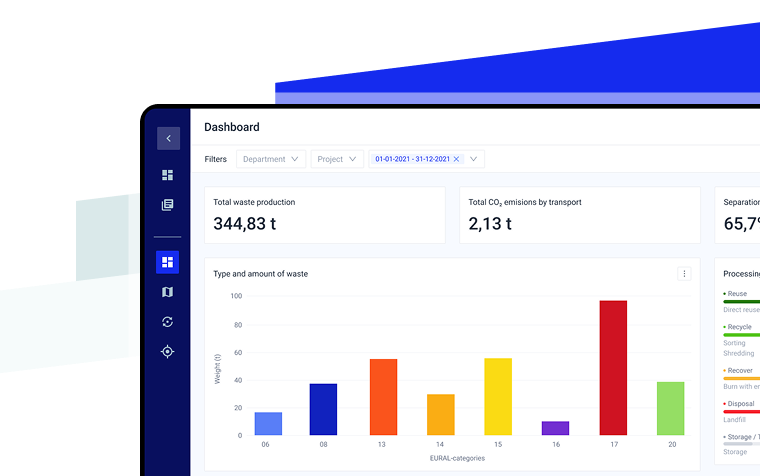“Over the years we’ve invested significantly in our field data team - focusing on producing trusted ratings. While this ensures the accuracy of our Ratings, it doesn’t allow the scale across the thousands of projects that buyers are considering.”
For more information on carbon credit procurement trends, read our "Key Takeaways for 2025" article. We share five, data-backed tips to improve your procurement strategy.

One more thing: Connect to Supply customers also get access to the rest of Sylvera's tools. That means you can easily see project ratings and evaluate an individual project's strengths, procure quality carbon credits, and even monitor project activity (particularly if you’ve invested at the pre-issuance stage.)
Book a free demo of Sylvera to see our platform's procurement and reporting features in action.
Introduction
The world of automation is moving fast. From AI-driven logistics to predictive manufacturing, every industry is finding new ways to make operations smarter and more efficient — and waste management is no different.
When we look at automation in waste, three main areas stand out:
- Data automation – Platforms that automatically collect and standardise waste information from different sites and partners. They replace manual data entry with real-time insights into waste generation, material flows, and performance trends.
- Material and process automation – Smart sensors, AI vision, and robotic sorting systems that detect, separate, and measure waste materials automatically, improving recycling rates and resource recovery.
- Operational and logistics automation – Tools that use IoT and GPS data to plan and optimise waste collection routes, cutting fuel use, costs, and emissions while improving service efficiency.
In this article, we’ll explore how automation is reshaping waste management — why it matters, and which tools are leading the change across these three fields.
Why Waste Automation Tools Are Essential in 2025
Waste management is full of repetitive work: collecting data, scheduling pickups, checking weights, and chasing paperwork from contractors. Automation offers an opportunity for waste processors, waste collectors, and waste producers to shift from labour-intensive manual work to connected systems that work faster, more accurately, and with less effort.
1. Efficiency and speed
Automated systems replace fragmented communication and manual data entry with real-time updates. Sensors can monitor container levels, AI tools can detect material types instantly, and digital platforms can synchronise data across multiple partners. The result is faster turnaround, fewer errors, and a clearer overview of what’s happening day to day.
2. Cost and resource optimisation
Automation reveals inefficiencies that are easy to overlook. Over-serviced collection points, empty truck routes, and poorly sorted waste all add hidden costs. Route optimisation, container monitoring, and automated analytics help organisations reduce unnecessary trips, cut fuel use, and make better use of transport and processing capacity.
3. Sustainability and circularity
By tracking materials more precisely, automation supports a more circular use of resources. Smart sorting systems increase recycling rates and material purity, while data platforms show exactly how much waste is diverted from disposal. Together, these technologies help businesses reduce environmental impact and make more informed decisions about material recovery and reuse.
6 Tools That Save Time and Ensure Accuracy
Automation in waste management is evolving fast — from AI that reads waste manifests to predictive routing systems that plan collections before bins are full. These six companies show how automation transforms every stage of the waste cycle, from data and materials to logistics.
1. geoFluxus
📍 Netherlands | 🏢 Enterprises managing waste across multiple sites | 🤖 Data automation
geoFluxus automates one of the most time-consuming parts of waste management: collecting and interpreting data from dozens of different sources. Its AI-powered document engine scans invoices, transport manifests, weighbridge tickets, and compliance forms — whether typed, scanned, or handwritten — and automatically extracts and standardises the key information.
The platform then cross-checks entries for completeness, consistency, and regulatory accuracy, instantly flagging anomalies that would take a human days to find. This automation turns raw, fragmented records into a single verified dataset that updates in real time. For enterprise teams, that means faster analysis, clearer visibility over material flows, and data they can finally trust to make decisions on cost, performance, and circularity.
2. Resourcify
📍 Germany | 🏢 Large businesses and recyclers | 🤖 Data automation
Resourcify brings automation to the operational side of waste management. Through its digital platform, companies can manage pickups, documentation, and partner communication without email chains or manual data entry. Smart workflows automatically generate and update consignment notes, invoices, and performance dashboards, giving all stakeholders access to one consistent set of data.
The result is less administrative work, fewer reporting errors, and a clearer picture of how waste moves through the organisation. By automating these routine interactions, Resourcify helps businesses focus on improving recycling rates and resource recovery instead of chasing paperwork.
3. Greyparrot
📍 United Kingdom | 🏢 Recycling plants and material recovery facilities | 🤖 Material & process automation
Greyparrot uses AI vision systems to bring digital intelligence to physical sorting lines. High-speed cameras and deep-learning models recognise materials in real time — identifying plastics, metals, paper, and even contamination levels as waste moves along conveyor belts.
Every detection is logged and analysed, creating a continuous stream of composition data. This helps operators improve sorting accuracy, recyclate purity, and operational efficiency while giving waste producers detailed feedback on what happens to their materials. Greyparrot shows how automation can turn waste sorting into a measurable, data-rich process.
4. AMP Robotics
📍 United States | 🏢 Recycling facilities and processors | 🤖 Material & process automation
AMP Robotics builds robotic sorting systems powered by computer vision and machine learning. The robots automatically identify and pick materials from mixed waste streams at high speed, dramatically improving recovery rates and consistency.
Over time, the AI learns to recognise new packaging types and material compositions, continuously refining its accuracy. Beyond the mechanical automation, AMP also provides detailed datasets on the quantity and type of recyclables processed — insight that helps operators track efficiency and support circular economy strategies.
5. Reen (formerly Enevo)
📍 Finland | 🏢 Waste collectors, municipalities, and logistics operators | 🤖 Operational & logistics automation
Reen transforms waste collection from scheduled to predictive. Using smart sensors installed in bins and containers, it monitors fill levels and applies AI forecasting to predict when each container will need servicing. The system then generates optimal collection routes based on real-time demand, distance, and fleet capacity.
This automation eliminates unnecessary trips and idle driving, cutting fuel use, emissions, and costs. For operators and cities, it creates a leaner, more sustainable logistics network — one that collects waste only when it’s actually needed.
6. WasteHero
📍 Denmark | 🏢 Waste service providers and municipalities | 🤖 Operational & logistics automation
WasteHero connects vehicles, drivers, and customers through a single intelligent platform. Its routing engine uses IoT data and GPS tracking to plan and dynamically adjust collection routes as conditions change — from road closures to container fill levels.
Automated scheduling balances workloads across the fleet and optimises vehicle capacity, while live dashboards show progress and performance in real time. By combining route optimisation with operational control, WasteHero helps waste companies run smoother, faster, and more sustainable collection services.
Conclusion
Automation in waste management is transforming how organisations understand and control their waste — but not every business needs robots or route optimisation software. For most enterprises whose core business isn’t waste, the real opportunity lies in data automation.
Instead of chasing paperwork from processors and contractors, automation gives companies a single, accurate view of their waste footprint. AI-powered systems extract information from invoices, manifests, and weighbridge tickets automatically, turning static documents into dynamic data. That means:
- Less manual work – no more spreadsheets or duplicate entries across sites.
- Faster insight – real-time visibility into waste volumes, materials, and costs.
- Better decisions – reliable data that reveals inefficiencies and opportunities for circular improvements.
- Verified reporting – information you can trust in audits, tenders, or sustainability disclosures.
While material and logistics automation help processors and collectors run more efficiently, data automation is what allows enterprises to connect those operational realities back to business performance. It’s the bridge between waste management, sustainability, and strategy.
In that sense, automation isn’t about replacing people or trucks — it’s about replacing uncertainty with clarity. For enterprise teams, that clarity turns waste from a compliance burden into a measurable business advantage.
👉 See how this works in practice: Book a demo with geoFluxus to discover how data automation can give your organisation complete visibility and control over its waste data.
FAQs
What are the best automation tools for waste management?
The best tools depend on your role in the waste management industry. Waste management companies and recyclers benefit from technologies like automated sorting systems (e.g., AMP Robotics and Greyparrot) that use AI algorithms to identify and separate recyclable materials and organic materials from solid waste.
Enterprises whose main goal is to track and manage waste data use platforms such as geoFluxus and Resourcify. These tools automate the waste management process, replacing manual data handling with intelligent systems that improve data quality, enhance efficiency, and support progress toward sustainability goals.
How do automated waste management systems support compliance?
Automation enhances compliance by ensuring accuracy and traceability throughout the waste management process. Digital platforms standardise and verify information from waste collection systems, transporters, and recyclers — providing defensible records of how municipal solid waste, trash, and recyclable materials are handled and disposed of.
By reducing human error and improving data quality, these technologies help organisations align with regulations on solid waste management, landfills, and recycling targets while supporting broader sustainable development efforts.
What ROI can enterprises expect from data automation in waste management?
Enterprises typically see faster reporting cycles and measurable cost savings. Automated data handling can deliver a 60–90% reduction in manual work and up to 75% faster reporting, while significantly improving data accuracy and revealing hidden inefficiencies in waste transport and processing contracts. The payoff is not just speed — it’s confidence in the numbers that underpin sustainability, compliance, and procurement decisions.
How does geoFluxus differ from hardware-based solutions?
Hardware solutions — such as sensors or compacting bins — automate physical waste operations. geoFluxus automates the data that sits behind them. It uses AI to read, extract, and verify information from invoices, manifests, and weighbridge tickets, regardless of format or origin. This turns fragmented documentation into one consistent dataset ready for analysis, benchmarking, or reporting.
Can automation help reduce Scope 3 waste emissions reporting risks?
Automation provides verified information about how materials are collected, transported, and processed — including different types of solid waste, contaminated materials, and recyclable materials. By tracing where waste is sent (for example, recovery facilities vs landfills) and how it’s treated, AI-driven tools can calculate more precise emissions linked to waste disposal. This improves accuracy in Scope 3 reporting and supports corporate sustainability goals for a more sustainable future.
How does automation contribute to a more sustainable waste management industry?
Automation allows both waste management companies and enterprises to operate more efficiently and sustainably. By reducing unnecessary transport, improving sorting accuracy, and supporting recycling processes, AI-based technologies lower environmental impact and energy use.
These innovative solutions play a key role in achieving a cleaner environment, improving public health, and accelerating the development of a circular, data-driven, and sustainable future for the entire solid waste management ecosystem.









